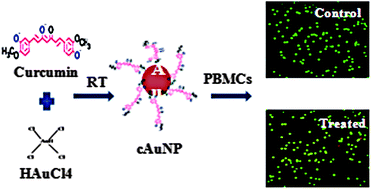Curcumin conjugated gold nanoparticle synthesis and its biocompatibility†
Abstract
Gold nanoparticles have gained much attention due to their widespread biological and technological applications, and consequently their simpler synthesis via green chemistry has also become of foremost importance. We report the room temperature synthesis of spherical gold nanoparticles using curcumin alone as the reducing and stabilizing agent. The pH is found to have an important role in curcumin solubilisation and subsequent formation of curcumin conjugated gold nanoparticles (cAuNPs). UV-visible studies show that the cAuNPs formed are of uniform size and HRTEM studies confirm spheres of average size 18 nm. The DLS measurements show a particle size of 58 nm. The crystallinity has been determined by HRTEM and XRD. The conjugation of stable curcumin on the cAuNPs is indicated by FTIR spectra which also suggest that the phenolic and enolic groups of curcumin bring about the reduction. The zeta potential value of cAuNPs is −23 mV which is stable for up to 6 months at room temperature. The mechanism of cAuNP formation is inferred to be through temporal evolution. This is the first demonstration where curcumin is solubilized at alkaline pH without using any external agent and is used for reducing HAuCl4 to form cAuNPs. The non toxic nature of the cAuNPs is evidenced through biocompatibility studies using human blood cells.


 Please wait while we load your content...
Please wait while we load your content...